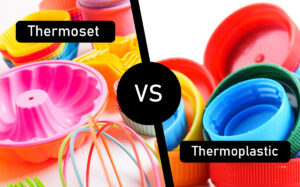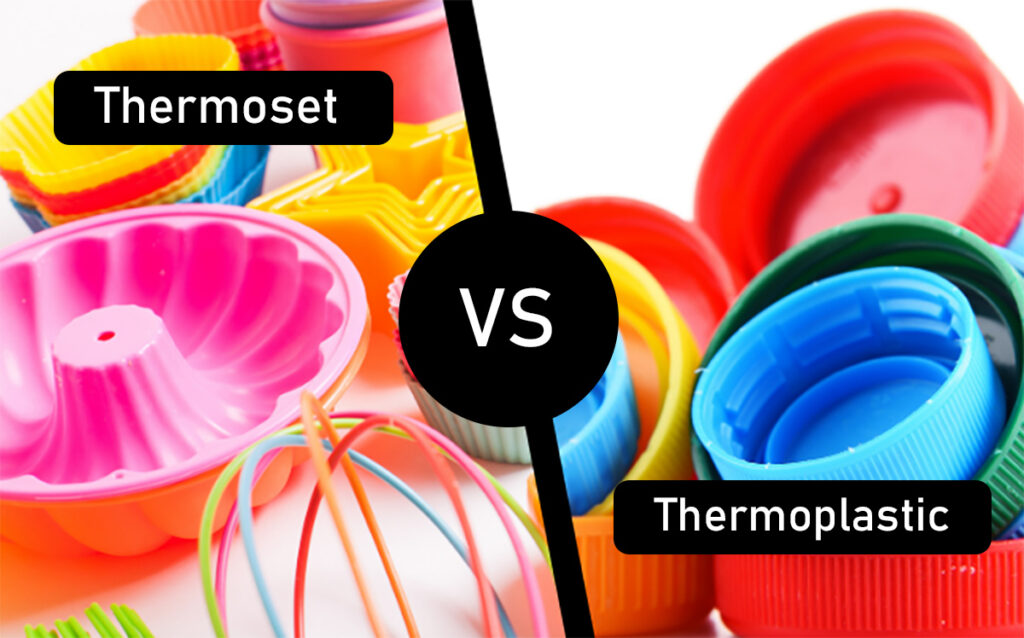BLOG
Thermoplastics vs. Thermosets – What is the Difference?
Thermoplastics vs. Thermosets
Thermoplastics and thermosets are two major categories of polymers used in manufacturing and product design. They have distinct characteristics and applications based on how they respond to heat and their structural properties. Here’s a comparison:

Thermoplastics
Thermoplastics are polymers that become soft and moldable upon heating and harden upon cooling. This process can be repeated multiple times without significant degradation, allowing for recycling and reshaping.
Pros:
- Reusability: Thermoplastics can be reheated, reshaped, and recycled multiple times, making them more environmentally friendly.
- Ease of Processing: They are easy to mold and form, making manufacturing simpler and more cost-effective. Methods like injection molding and extrusion are commonly used.
- Flexibility: Thermoplastics offer excellent flexibility and impact resistance, making them ideal for products requiring elasticity.
- Variety: There is a wide range of thermoplastics available, each with different properties, allowing for diverse applications.
- Chemical Resistance: Many thermoplastics are resistant to chemicals and corrosion, making them suitable for packaging and industrial uses.
Cons:
- Lower Heat Resistance: Thermoplastics can soften or deform at higher temperatures, limiting their use in high-temperature environments.
- Lower Structural Strength: Compared to thermosets, thermoplastics generally have lower structural strength and may not be suitable for high-stress applications.
- Potential for Creep: Over time, under constant stress, thermoplastics can exhibit creep (gradual deformation), which may limit their use in load-bearing applications.
Common Examples:
- Polyethylene (PE): Used in plastic bags, bottles, and containers.
- Polypropylene (PP): Used in automotive parts, textiles, and packaging.
- Polyvinyl Chloride (PVC): Used in pipes, cable insulation, and window frames.
- Acrylonitrile Butadiene Styrene (ABS): Used in LEGO bricks, automotive parts, and consumer electronics.
Applications:
- Packaging: Bottles, films, and containers.
- Automotive: Interior and exterior parts, under-the-hood components.
- Consumer Goods: Toys, appliances, and electronics.
Thermosets
Thermosets are polymers that undergo a chemical change when heated, creating a rigid, infusible, and insoluble material. Unlike thermoplastics, once thermosets are set, they cannot be remelted or reshaped.
Pros:
- High Structural Strength: Thermosets are strong and rigid, making them ideal for applications requiring durable and high-stress materials.
- Excellent Heat Resistance: Once cured, thermosets can withstand high temperatures without softening or melting, suitable for high-heat applications.
- Chemical Resistance: Thermosets are highly resistant to chemicals, solvents, and corrosion, making them suitable for harsh environments.
- Dimensional Stability: They maintain their shape and strength over time, even under stress, without exhibiting creep.
- Durability: Thermosets are highly durable and resistant to wear and tear, making them suitable for long-lasting applications.
Cons:
- Non-Reusability: Once cured, thermosets cannot be reheated or reshaped, which limits their recyclability and increases waste.
- More Complex Processing: The curing process of thermosets is more complex and time-consuming, which can increase manufacturing costs and time.
- Brittleness: Thermosets can be more brittle than thermoplastics, making them susceptible to cracking under impact or excessive stress.
- Limited Flexibility: Thermosets are generally less flexible than thermoplastics, which may limit their use in applications requiring elasticity.
Common Examples:
- Epoxy Resin: Used in adhesives, coatings, and composite materials.
- Phenolic Resin: Used in electrical insulators and heat-resistant applications.
- Polyester Resin: Used in fiberglass-reinforced plastics, automotive parts, and boat hulls.
- Polyurethane: Used in foam products, coatings, and sealants.
Applications:
- Electronics: Printed circuit boards, insulators, and connectors.
- Aerospace and Automotive: High-strength composite materials, engine components.
- Construction: Adhesives, coatings, and sealants.
- Industrial Equipment: Heat-resistant parts, wear-resistant surfaces.
Key Differences
- Reusability: Thermoplastics can be reheated and reshaped, making them recyclable. Thermosets cannot be reshaped once set, limiting their recyclability.
- Strength and Durability: Thermosets tend to be stronger and more durable, making them ideal for high-stress applications. Thermoplastics, while versatile, may not offer the same level of rigidity or heat resistance.
- Processing: Thermoplastics are easier to process and mold into various shapes. Thermosets require careful control of the curing process and cannot be remolded once set.
Conclusion
Both thermoplastics and thermosets offer distinct advantages and disadvantages depending on the application. Thermoplastics are favored for their flexibility, ease of processing, and recyclability, while thermosets are chosen for their strength, heat resistance, and durability. Selecting the right material depends on the specific requirements of your project.


